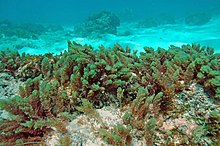Asparagopsis taxiformis
| Limukohu | |
|---|---|
 |
|
| Asparagopsis taxiformis in Mayotte. | |
| Scientific classification | |
| (unranked): | Archaeplastida |
| Division: | Rhodophyta |
| Class: | Florideophyceae |
| Order: | Bonnemaisoniales |
| Family: | Bonnemaisoniaceae |
| Genus: | Asparagopsis |
| Species: | A. taxiformis |
| Binomial name | |
|
Asparagopsis taxiformis (Delile) Trevis. |
|
| Synonyms | |
|
Asparagopsis sanfordiana |
|
Asparagopsis sanfordiana
Asparagopsis taxiformis, limu kohu formerly A. sanfordiana, is a species of red algae, with cosmopolitan distribution in tropical to warm temperate waters.
Like many red algae, A. taxiformis has a haplodiplophasic lifecycle, each phase being morphologically distinct. Indeed the species haploid haploid stage was initially described as Falkenbergia hillebrandii (Bornet) Falkenberg 1901 because it was thought to be a separate species.
Asparagopsis is one of the most popular types of limu. in the cuisine of Hawaii, principally as a condiment. It is known as Limu kohu in the Hawaiian language meaning "pleasing seaweed". Limu kohu is a traditional ingredient in poke.
The essential oil of limu kohu is 80% bromoform (tri-bromo-methane). by weight, and includes many other bromine- and iodine-containing organic compounds.
Researchers in 2016 released a study showing that when added to a cow's diet, Asparagopsis taxiformis could reduce methane production by 50%-70%.
Guiry, M.D.; Guiry, G.M. (2008). "'Asparagopsis taxiformis'". AlgaeBase. World-wide electronic publication, National University of Ireland, Galway.
...
Wikipedia
